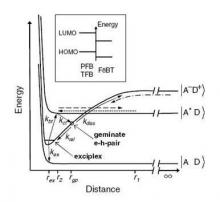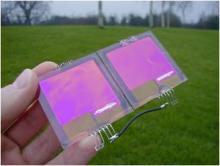 Organic semiconductors are attractive as the active layer in solar cells since they can be deposited cheaply by printing over large areas. The process of generating charges following light absoprtion takes place at the interface between two different organic semiconductors, and we are currently investigating the complex physical processes that occur at polymer interfaces in order to improve the efficiency of organic solar cells.
Organic semiconductors are attractive as the active layer in solar cells since they can be deposited cheaply by printing over large areas. The process of generating charges following light absoprtion takes place at the interface between two different organic semiconductors, and we are currently investigating the complex physical processes that occur at polymer interfaces in order to improve the efficiency of organic solar cells.
The Physics
The operation of a polymer solar cell is governed by the key steps of light-absorption, charge generation and charge collection.
- When light is absorbed by a conjugated polymer, an exciton (bound electron-hole pair) is created.
- To generate a photocurrent these excitons need to be split up into free charges.
- The electron and hole need to be able to move freely through the polymer film to the respective contacts where they are collected.
To improve the performance of polymer cells, each of the steps in the process needs to be understood and carefully optimised through judicious choice of materials and processing conditions.
A fundamental issue is the nature of intermediate states in the critical charge separation processes at the hetero-interface. When the exciton is split at the interface, the electron and hole remain under the influence of their mutual Coulomb interaction. In many materials a Charge Transfer (CT) state is formed, in which electron and hole remain bound at the interface. Understanding the formation of such CT states is critically important to optimise the efficiency of charge separation in a polymer solar cell.
 The Application
The Application
Polymer cells can be made with a power conversion efficiency of 9%, which is still somewhat lower than that of inorganic silicon solar cells with efficiencies on the order of 15%. However, the performance is steadily improving - and polymer solar cells promise to enable much lower production costs because the active layers can be deposited from solution.
Following a development programme funded by the Carbon Trust, a start-up company called Eight19 has been created to manufacture efficient and inexpensive solar cells using organic semiconductor materials.
